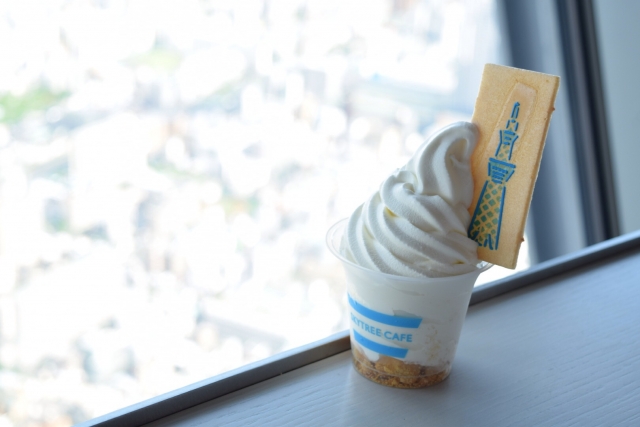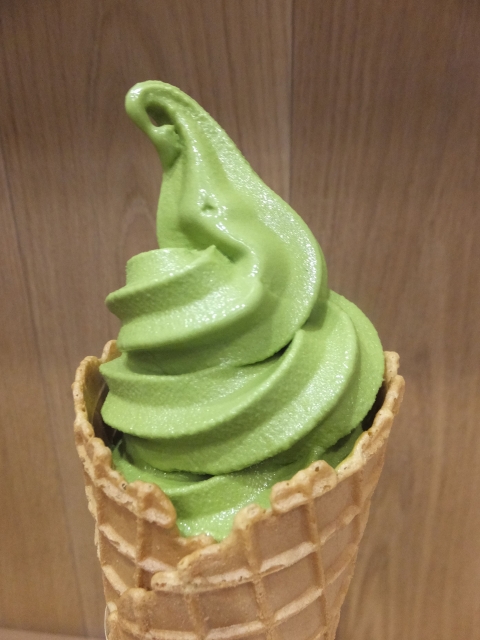How To Beat The Heat in Japan (Part 2)- Soft Cream
In our first article of mid-summer we introduced kakigori, a frozen shaved ice dessert traditionally loved, yet making a revival hit in today’s Japan. This second article will look at soft cream, a dairy, western-influenced dessert which is a crowd pleaser all year round but particularly popular during summer. Here in Japan soft serve ice cream is called soft cream. Statistics show that approximately 0.5 billion soft creams are consumed annually across the nation. Soft cream is typically lower in milk fat than ice cream and contains air during the process of freezing. It is generally churned and served quickly with a special machine at the point of sale. The beautifully twisted twirl shape of soft cream is almost artistic – it takes the person who’s serving some practice to perfect it.
Soft cream finds its origin back in the 1930s when the owner of an ice cream van named Tom Carvel suffered a flat tire at Hartsdale, New York. He had no choice but to offer melting ice cream to the customers but managed to sell the entire stock within a couple of days. Carvel later founded a major ice cream franchise which today has shops across the States. Between the late1940s and early 1950s, an aspiring graduate from Oxford University with a degree in Chemistry worked for a food conglomerate as a researcher. Rumor has it that the said researcher was involved in developing a soft serve recipe with emulsifiers by using machines from America. She later became the first female Prime Minister in the United Kingdom. It is often joked that during this time the late Margaret Thatcher had developed her political stance: “added air, lowered quality and raised profits”.

Soft serve made its way to Japan after the Second World War. On July 3 1951 there was a festival celebrating the Independence Day of the United States on the site of Meiji Shrine. The Americans were serving soft serves at a food stall from the machine they brought from home. With second hand soft serve machines sold to the locals by the occupying troops and production of ice cream mix started by domestic food manufacturers, it became more accessible to the public by the mid-1950s. Soft serve was renamed soft cream during the course. It was offered as refreshment at department stores, coffee shops, and restaurants alike. The second wave of soft cream hype came in 1970 during the Japan World Exposition. Approximately 200 soft cream machines were installed to cater for 6 million visitors over the 6-month period. Eating soft cream while strolling from one pavilion to another was seen as trendy. Starting to be served at convenience stores, food courts in shopping malls and parking areas of highways, soft cream gradually became one of the nation’s favorite frozen desserts. In 1990 an industrial body of soft cream manufacturers was founded.

Today the soft creams are extremely diversified with a large variety to choose from. The flavor variations used to be limited to vanilla, strawberry and chocolate. Now they are countless- from fruits and vegetables such as peach, apple, grape, citrus, kiwi fruits, mango, melon, water melon, tomato, corn, pumpkin, and sweet potatoes, to Japanese cuisine-inspired ingredients: miso, wasabi, soy sauce, tofu, seaweed, ume (pickled plums), black sugar and matcha, to name a few. Flower scented such as rose, cherry blossom and lavender are also spotted. Bizarre seafood flavors like scallop or whitebait flavors are unique to places by the sea renowned for fresh seafood. Many eccentric flavors could be either seasonal or regional but if you come across any, you may want to be daring and give it a try for a once-in-a-life experience. There are of course rather predictable flavors you might come across, similar to ice cream and gelato- caramel, salt caramel, pistachios, coffee, tea, honey, maple syrup, and many, many more!
As for the latest trends, full fat milk from notable dairy farming sites such as Hokkaido are gaining popularity. Combining creaminess with the airiness of soft cream gives a melt-in-your-mouth effect. Swapping an ordinary wafer ice cream cone with either a waffle cone or a thinly baked biscuit rolled into cone shape is also very popular. Waffle cone is thick and maintains its crispiness till the very end whereas the biscuit version has a smooth and light crunchy texture. The latter even becomes soggy and the soft cream will start to leak if you don’t eat in a hurry. If you like Japanese soft cream with a wide range of flavors it offers, there is just the place for you near Nakano Station in Tokyo. Its biggest serving is a spectacular, eight-story tower of soft cream. You can order different flavor for each twirl. It is so big that many Japanese would share among two or three family members or friends, but wouldn’t it be something memorable to savor on a hot and muggy summer day in Japan?
